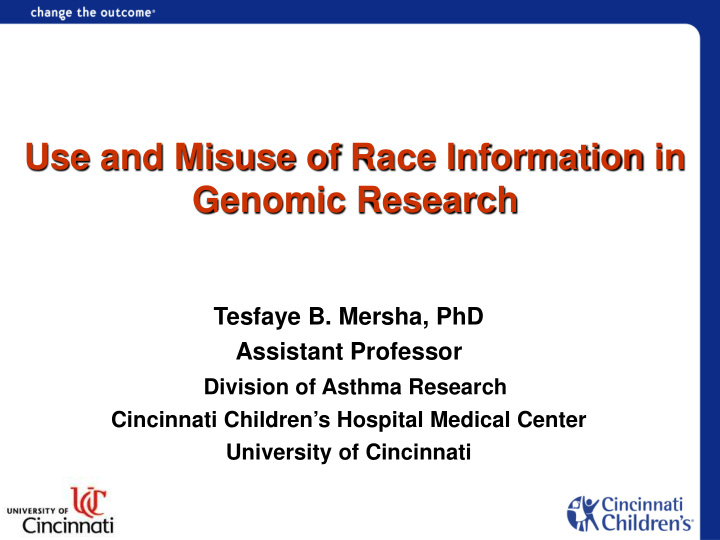



Use and Misuse of Race Information in Genomic Research Tesfaye B. Mersha, PhD Assistant Professor Division of Asthma Research Cincinnati Children’s Hospital Medical Center University of Cincinnati
Why race matters? Every indicator of well-being shows disparities by race. Race: physical markers (e.g. color)- it combines both genetic and environmental determinant of health . Ethnicity: Cultural markers - shared religion, race, language, or place of origin. Ancestry: Genetic markers - it is a statistical product and refers to an individual’s genetic origin/background.
Outline Human origin and variation Race versus ancestry Does race exist, and matters? Admixed ancestry to study health disparities Ancestry and its measures AncestrySNPminer … Discussion points
Potential questions about race and ancestry Q1: Can scientist determine a person’s race by looking at his or her DNA? Q2: What does skin color tell you about a person? Q3. Are there race-specific genes? Q4. Can ancestry be a substitute for defining race or vice versa ? Q5. Is ancestry, rather than race, a better predictor of disease risk? Q5. Is knowing the patient’s race helps the doctor make an accurate diagnosis?
Human Origin KENYA Lucy The ‘First Human’ discovered in Ethiopia
Human Origin We all are Ethiopians: Either living in Ethiopia or in recent exile! http://www.academyll.org/wordpress/assets/Human-Migration-chart.pdf
Genetic variation in SNPs ATTGCAATCCGTGG...ATCGAGCCA…TACGATTGCACGCCG… ATTGCAAGCCGTGG...ATCTAGCCA…TACGATTGCAAGCCG… ATTGCAAGCCGTGG...ATCTAGCCA…TACGATTGCAAGCCG… ATTGCAATCCGTGG...ATCGAGCCA…TACGATTGCACGCCG… ATTGCAAGCCGTGG...ATCTAGCCA…TACGATTGCAAGCCG…
How is variation distributed within and between populations 15% 10-15% White Asian 85% 85-90% Mersha, Human Genomics 2011
Comparison of completely sequenced individuals Watson and Venter share more alleles with Kim than with each other European ancestry Asian ancestry James Watson 1,715,851 Seong-jin Kim Craig Venter Geographic ancestry doesn’t correspond to genetic ancestry • The best way to know a person’s DNA is to study that person’s DNA not his/her race or geographic ancestry. Genome Res 2009, 19(9):1622-9
Genetic variation race or phenotypic variation http://blogs.gonomad.com/readuponit/2007/07/tall-meets-short-in-china.html
Genetics and race
Who is Self-identified black, Latino, white? Human diversity forms a gradient rather than discrete clusters 4 -2 0 2 -6 -4 4 4 https://www.youtube.com/watch?v=CRcex9NEJZE
Self-reported race and admixed ancestry Broad peak for self-reported blacks due to admixture and absence of a single origin. NEJM, 354;4 (2006)
Ancestry proportion of European and African Americans across the United States 23andMe- genetic testing company with over 800,000 customers - about 80% of given their permission to participate in this study 5,269 self-reported AAs and 148,789 EAs and >1/2 M SNPs European Americans African Americans - EA with African ancestry are found at much higher frequencies in southern states. - African ancestry among self-reported AAs are found highest in southern states, especially South Carolina and Georgia. The American Journal of Human Genetics 96 (1): 37-53, 2015.
Self-reported race is NOT a good proxy for ancestry Wayne Joseph, Principal of a high school from southern California Mr. Joseph considered himself as ‘black’ for 50 years but DNA PRINT Genomics Test finds out that he has NO African ancestry. https://chancellorfiles.wordpress.com/
Do human “races” exist? Human populations have never been isolated long enough to form true biological races. If races are defined as “ genetically discrete groups ”, then the answer is NO. However, one can use race information to group individuals into clusters and identify factors related to health disparities . Scientific American, December 2003
Misuse of race information in genomics - Genotype information from self-reported races are used to infer continental racial group: - HapMap data: YRI genotype data from Nigeria to infer the entire African continent. - Race comparison in disease genetics without controlling socio-environmental risk factors. - Application of ancestry-related variants to psychological and health related-traits - Ancestry-related variants perceived as undesirable--health insurance purpose! there is NO white gene or black gene!
Under what conditions should we use race? • To identify societal construct such as health and income disparities. - unequal treatment due to actual/perceived race. • To identify non-genetic causes of health disparities (shared environmental risk factors). - Environmental exposure such as traffic pollution, dust, cigarette smoke, etc.
Prevalence of asthma in children in the U.S. 20 Asthma Prevalence (%) 15 10 5 0 Puerto Ricans African Americans European Americans Mexican Americans Asian Americans Asthma prevalence is the highest in Puerto Rican and the lowest in Mexicans BUT both are Latino/Hispanics?
Ancestry proportion: Mexicans vs. Puerto Ricans Genome Biol. 2009;10(11):R132
Income differs by ancestry Race can’t inform the racial gap in income European Journal of Human Genetics (2008) 16, 762–765
Discussion points • Human adaptation over years created population with different skin color, hair texture---attribute to “race.” • There is no black race gene or white race gene. • Race and ancestry capture different information and can’t substitute each other. • Emphasizing group differences based ancestry could lead to further disparities in health and healthcare outcomes • Both ancestry and race information should be considered to shade light on heath disparities. • Health disparities are the product of complex interactions of racial/ethnic information, ancestry/genes and environments.
Acknowledgements Funding: K01HL103165 Thank you
“ The classic mirror reflects skin color ; but the DNA mirror reflects our common ancestors. ” Beatriz Marcheco, 2014
Recommend
More recommend